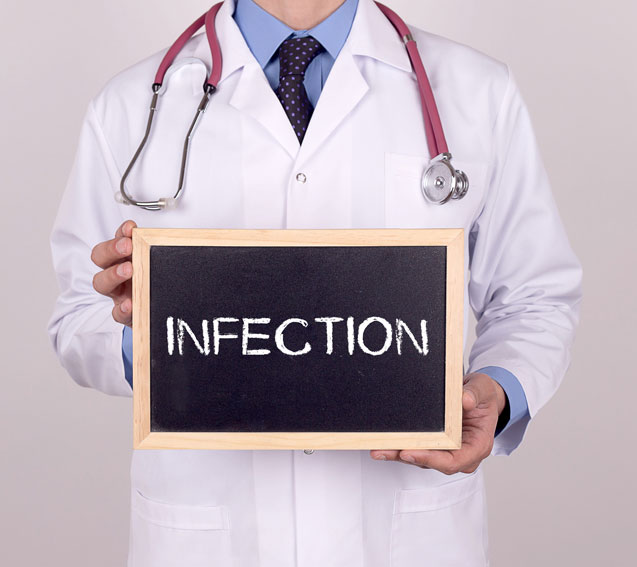If you or a loved one has been injured by a doctor or hospital, Call the Medical Malpractice Crisis Resource Line for Immediate Help >
Free Consultation. Call Now. (516) 394-4200
(516) 394-4200

Hospitals are supposed to be the place you go to get better.
Unfortunately, that’s not the case for millions of Americans. The Centers for Disease Control and Prevention (CDC) estimates that 1.7 million patients acquire an infection in a U.S. hospital each year. Of those, nearly 100,000 will die from resulting complications.
Treating these healthcare-associated infections (HAIs) amounts to anywhere from $20-30 billion in direct medical costs annually.
As frightening as that may sound, it gets worse: many experts and watchdog groups believe those numbers are laughably conservative. The Committee to Reduce Infection Death (RID), a non-profit organization working to reduce and eliminate the number of hospital-acquired infections in the U.S., believes the number may actually be several times that. Their research revealed that instances of methicillin-resistant staphylococcus aureus (MRSA) alone amounts to 880,000 cases each year. And that’s just one example.
The CDC admits their numbers “may” be low. Infections are almost routine at most hospitals now.
They can happen anywhere, even in hospitals with stringent prevention protocols. Sadly though, many of them are easily preventable, and are a direct result of medical malpractice or negligence.
Take Staphylococcus (typically called “staph” for short), for example. Many people carry this bacteria on them without risk or infection. The problem arises when it finds a way into the body, usually via a wound or surgical incision. A localized staph infection may be red, swollen, and develop a boil or pus. The bacteria can lead to serious complications and even death if left untreated.
Staph is a resilient bacteria that can survive on surfaces and linens, and can be transmitted person-to-person. That’s a dangerous scenario in a hospital setting.
One type of staph – methicillin-resistant staphylococcus aureus (MRSA) – has developed a strong resistance to the antibiotics used for treatment. It can cause mild infections of the skin, but it can also infect the urinary tract, the lungs, and the bloodstream. Roughly 2% of the adult population carry it, and you can pick it up by touching a contaminated object or person.
Another all-too-common HAI is catheter-associated bloodstream infection (aka central line-associated bloodstream infection). These infections occur in ICUs and recuperation wards when a patient has a catheter tube inserted into their body to draw blood or give fluids and medication. Harmful bacteria or viruses can enter via the insertion point, or travel down the central line to reach the bloodstream.
Some strains of the enterococci bacteria have become resistant to many antibiotics used in hospitals. Vancomycin-resistant enterococci – or VRE – is some such kind. VRE infections can occur in hospitals and affect the urinary tract, the bloodstream, or wounds associated with catheters or surgical procedures. It’s spread via person-to-person contact and inadequate cleaning protocols.
Finally, the bacterium Clostridium difficile – or C. diff. for short – is found in the gastrointestinal tracts of roughly 5% of the population, and it’s usually kept under control by other bacteria present there. Patients on antibiotics in a hospital setting may experience a bacterial imbalance, allowing C. diff to take over and cause diarrhea or infection of the colon. It is transferred through oral-fecal contamination.
What do all of these have in common? They shouldn’t occur at all, or at least not in the numbers we currently see. All of them can be either reduced or eliminated with proper prevention methods. And the biggest one is adequate cleaning and disinfection of surfaces, surgical instruments, and hands.
Infections like these are preventable and may be the result of medical malpractice. Frequent hand washing alone can drastically reduce the number of cases.
Studies have shown that proper sterilization of the environment, instruments, wounds, incision sites, and hands go a long way towards reducing the risks. That said, many doctors and nurses simply fail to consistently follow protocols.
Screening all incoming patients for MRSA has also proven effective, but is not standard operating procedure for most healthcare facilities.
These infections are preventable. Perhaps not 100% of the time, but the vast majority. Failure to sterilize, failure to screen incoming patients, or worse, failure to identify and treat an infection once it’s taken root, are all examples of potential malpractice cases.
RID has created a 15 step checklist to reduce your risk, but hospital-acquired infection still kills more people each year than breast cancer and AIDS combined. If you or someone you know has been the victim of an HAI as a result of malpractice, you may be entitled to compensation.
Contact the medical negligence and malpractice attorneys at Duffy & Duffy, PLLC to discuss your case today. A hospital should never be the source of pain and suffering. It’s supposed to be the solution.
No. Our injury cases are handled on a contingent retainer. You pay nothing upfront, and we recover attorney’s fees only if your litigation is successful. We don’t bill by the hour. You don’t need to worry about running up a large attorney’s bill before you see any recovery for your injuries.
Yes. Our firm is dedicated to creating a strong relationship with our clients, beginning with keeping your information and consultation confidential.
Each case we encounter is carefully screened and evidence scrutinized to make sure the claim is meritorious and may be successful at trial. We will perform an investigation, and then our partners make a final decision on whether to take on a case.